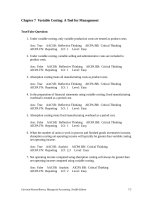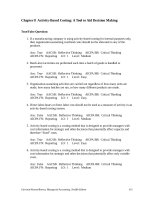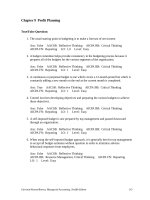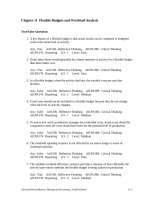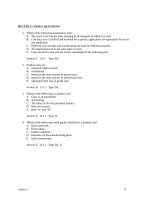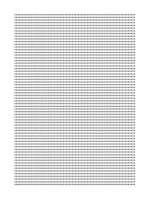Test bank managerial accounting by hilton 9e chapter09
Bạn đang xem bản rút gọn của tài liệu. Xem và tải ngay bản đầy đủ của tài liệu tại đây (161.22 KB, 33 trang )
MULTIPLE CHOICE QUESTIONS
1. Generally speaking, budgets are not used to:
A. identify a company's most profitable products.
B. evaluate performance.
C. create a plan of action.
D. assist in the control of profit and operations.
E. facilitate communication and coordinate activities.
Answer: A LO: 1 Type: RC
2. Which of the following choices correctly denotes managerial functions that
are commonly associated with budgeting?
Performance
Coordination
Planning
Evaluation
of Activities
A.
Yes
Yes
No
B.
Yes
Yes
Yes
C.
Yes
No
No
D.
Yes
No
Yes
E.
No
Yes
No
Answer: B LO: 1 Type: RC
3. A formal budget program will almost always result in:
A. higher sales.
B. more cash inflows than cash outflows.
C. decreased expenses.
D. improved profits.
E. a detailed plan against which actual results can be compared.
Answer: E LO: 1 Type: RC, N
4. A budget serves as a benchmark against which:
A. actual results can be compared.
B. allocated results can be compared.
C. actual results become inconsequential.
D. allocated results become inconsequential.
E. cash balances can be compared to expense totals.
Answer: A LO: 1 Type: RC
Hilton, Managerial Accounting, Seventh Edition 234
5. The comprehensive set of budgets that serves as a company's overall financial plan is commonly
known as:
A. an integrated budget.
B. a pro-forma budget.
C. a master budget.
D. a financial budget.
E. a rolling budget.
Answer: C LO: 1 Type: RC
6. A company's plan for the acquisition of long-lived assets, such as buildings and equipment, is
commonly called a:
A. pro-forma budget.
B. master budget.
C. financial budget.
D. profit plan.
E. capital budget.
Answer: E LO: 1 Type: RC
7. Wilson Corporation is budgeting its equipment needs on an on-going basis, with a new quarter
being added to the budget as the current quarter is completed. This type of budget is most
commonly known as a:
A. capital budget.
B. rolling budget.
C. revised budget.
D. pro-forma budget.
E. financial budget.
Answer: B LO: 1 Type: RC
8. An organization's budgets will often be prepared to cover:
A. one month.
B. one quarter.
C. one year.
D. periods longer than one year.
E. all of the above.
Answer: E LO: 1 Type: RC
9. A manufacturing firm would begin preparation of its master budget by constructing a:
A. sales budget.
B. production budget.
C. cash budget.
D. capital budget.
E. set of pro-forma financial statements.
Answer: A LO: 1, 4 Type: RC
235
Hilton, Managerial Accounting, Seventh Edition
10. Which of the following budgets is based on many other master-budget components?
A. Direct labor budget.
B. Overhead budget.
C. Sales budget.
D. Cash budget.
E. Selling and administrative expense budget.
Answer: D LO: 1, 4 Type: N
11. The budgeted income statement, budgeted balance sheet, and budgeted statement of cash flows
comprise:
A. the final portion of the master budget.
B. the depiction of an organization's overall actual financial results.
C. the first step of the master budget.
D. the portion of the master budget prepared after the sales forecast and before the remainder of
the operational budgets.
E. the second step of the master budget.
Answer: A LO: 1, 4 Type: RC
12. Which of the following budgets is prepared at the end of the budget-construction cycle?
A. Sales budget.
B. Production budget.
C. Budgeted financial statements.
D. Cash budget.
E. Overhead budget.
Answer: C LO: 1, 4 Type: N
13. Which of the following would depict the logical order for preparing (1) a production budget, (2) a
cash budget, (3) a sales budget, and (4) a direct-labor budget?
A. 1-3-4-2.
B. 2-3-1-4.
C. 2-1-3-4.
D. 3-1-4-2.
E. 3-1-2-4.
Answer: D LO: 1, 4 Type: N
Chapter 9
236
14. The master budget contains the following components, among others: (1)
direct-material budget, (2) budgeted balance sheet, (3) production budget,
and (4) cash budget. Which of these components would be prepared first and
which would be prepared last?
First
Last
A.
1
4
B.
1
2
C.
3
4
D.
3
2
E.
4
1
Answer: D LO: 1, 4 Type: N
15. A company's sales forecast would likely consider all of the following factors except:
A. political and legal events.
B. advertising and pricing policies.
C. general economic and industry trends.
D. top management's attitude toward decentralized operating structures.
E. competition.
Answer: D LO: 1 Type: RC
16. Which of the following would be considered when preparing a company's
sales forecast?
Anticipated
General
Expected
Advertising
Economic
Competitive
Campaigns
Trends
Actions
A.
Yes
Yes
No
B.
Yes
No
Yes
C.
Yes
No
No
D.
Yes
Yes
Yes
E.
No
No
Yes
Answer: D LO: 1 Type: RC
17. Which of the following statements best describes the relationship between the sales-forecasting
process and the master-budgeting process?
A. The sales forecast is typically completed after completion of the master budget.
B. The sales forecast is typically completed approximately halfway through the master-budget
process.
C. The sales forecast is typically completed before the master budget and has no impact on the
master budget.
D. The sales forecast is typically completed before the master budget and has little impact on the
master budget.
E. The sales forecast is typically completed before the master budget and has significant impact
on the master budget.
Answer: E LO: 1 Type: N
237
Hilton, Managerial Accounting, Seventh Edition
18. Which of the following organizations is not likely to use budgets?
A. Manufacturing firms.
B. Merchandising firms.
C. Firms in service industries.
D. Nonprofit organizations.
E. None of the above, as all are likely to use budgets.
Answer: E LO: 2 Type: RC
19. Activity-based budgeting:
A. begins with a forecast of products and services to be produced, and customers served.
B. ends with a forecast of products and services to be produced, and customers served.
C. parallels the flow of analysis that is associated with activity-based costing.
D. reverses the flow of analysis that is associated with activity-based costing.
E. is best described by choices "A" and "D" above.
Answer: E LO: 3 Type: RC
20. A company that uses activity-based budgeting performs the following:
1—Plans activities for the budget period.
2—Forecasts the demand for products and services as well as the customers to be served.
3—Budgets the resources necessary to carry out activities.
Which of the following denotes the proper order of the preceding activities?
A. 1-2-3.
B. 2-1-3.
C. 2-3-1.
D. 3-1-2.
E. 3-2-1.
Answer: B LO: 3 Type: RC
21. Santa Fe Corporation has a highly automated production facility. Which of the following
correctly shows the two factors that would likely have the most direct influence on the company's
manufacturing overhead budget?
A. Sales volume and labor hours.
B. Contribution margin and cash payments.
C. Production volume and management judgment.
D. Labor hours and management judgment.
E. Management judgment and indirect labor cost.
Answer: C LO: 4 Type: N
Chapter 9
238
22. May Production Company, which uses activity-based budgeting, is in the process of preparing a
manufacturing overhead budget. Which of the following would likely appear on that budget?
A. Batch-level costs: Production setup.
B. Unit-level costs: Depreciation.
C. Unit-level costs: Maintenance.
D. Product-level costs: Insurance and property taxes.
E. Facility and general operations-level costs: Indirect material.
Answer: A LO: 4 Type: N
23. FastTec, which sells electronics in retail outlets and on the Internet, uses activity-based budgeting
in the preparation of its selling, general, and administrative expense budget. Which of the
following costs would the company likely classify as a unit-level expense on its budget?
A. Media advertising.
B. Retail outlet sales commissions.
C. Salaries of web-site maintenance personnel.
D. Administrative salaries.
E. Salary of sales manager employed at store no. 23.
Answer: B LO: 4 Type: N
24. Which of the following would have no effect, either direct or indirect, on an organization's cash
budget?
A. Sales revenues.
B. Outlays for professional labor.
C. Advertising expenditures.
D. Raw material purchases.
E. None of the above, as all of these items would have some influence.
Answer: E LO: 4 Type: N
25. Atlanta Sporting Goods sells bicycles throughout the southeastern United States. The following
data were taken from the most recent quarterly sales forecast:
April
May
June
Expected Sales
1,700 units
1,850 units
2,000 units
End-of-Month
Target Inventory
200 units
270 units
310 units
On the basis of the information presented, how many bicycles should the company purchase in
May?
A. 1,780.
B. 1,920.
C. 2,050.
D. 2,120.
E. Some other amount.
Answer: B LO: 4 Type: A
239
Hilton, Managerial Accounting, Seventh Edition
26. Swanson plans to sell 10,000 units of a particular product during July, and expects sales to
increase at the rate of 10% per month during the remainder of the year. The June 30 and
September 30 ending inventories are anticipated to be 1,100 units and 950 units, respectively. On
the basis of this information, how many units should Swanson purchase for the quarter ended
September 30?
A. 31,850.
B. 32,150.
C. 32,950.
D. 33,250.
E. Some other amount.
Answer: C LO: 4 Type: A, N
27. York Corporation plans to sell 41,000 units of its single product in March. The company has
2,800 units in its March 1 finished-goods inventory and anticipates having 2,400 completed units
in inventory on March 31. On the basis of this information, how many units does York plan to
produce during March?
A. 40,600.
B. 41,400.
C. 43,800.
D. 46,200.
E. Some other amount.
Answer: A LO: 4 Type: A
28. Coleman, Inc., anticipates sales of 50,000 units, 48,000 units, and 51,000 units in July, August,
and September, respectively. Company policy is to maintain an ending finished-goods inventory
equal to 40% of the following month's sales. On the basis of this information, how many units
would the company plan to produce in August?
A. 46,800.
B. 49,200.
C. 49,800.
D. 52,200.
E. Some other amount.
Answer: B LO: 4 Type: A
Chapter 9
240
29. Telcer & Company had 3,000 units in finished-goods inventory on December 31. The following
data are available for the upcoming year:
Units to be produced
Desired ending finished-goods inventory
January
9,400
2,500
February
10,200
2,100
The number of units the company expects to sell in January is:
A. 6,900.
B. 8,900.
C. 9,400.
D. 9,900.
E. 11,900.
Answer: D LO: 4 Type: A
30. Tidewater plans to sell 85,000 units of product no. 794 in May, and each of these units requires
three units of raw material. Pertinent data follow.
Actual May 1 inventory
Desired May 31 inventory
Product No. 794
11,000 units
17,000 units
Raw Material
29,000 units
20,000 units
On the basis of the information presented, how many units of raw material should Tidewater
purchase for use in May production?
A. 228,000.
B. 246,000.
C. 264,000.
D. 282,000.
E. Some other amount.
Answer: C LO: 4 Type: A
31. An examination of Short Corporation’s inventory accounts revealed the following information:
Raw materials, June 1: 46,000 units
Raw materials, June 30: 51,000 units
Purchases of raw materials during June: 185,000 units
Short’s finished product requires four units of raw materials. On the basis of this information,
how many finished products were manufactured during June?
A. 45,000.
B. 47,500.
C. 57,750.
D. 70,500.
E. Some other amount.
Answer: A LO: 4 Type: A
241
Hilton, Managerial Accounting, Seventh Edition
32. Nguyen plans to sell 40,000 units of product no. 75 in June, and each of these units requires five
square feet of raw material. Pertinent data follow.
Product No. 75
5,500
4,300
Actual June 1 inventory
Estimated June 30 inventory
Raw Material
18,000 square feet
? square feet
If the company purchases 201,000 square feet of raw material during the month, the estimated
raw-material inventory on June 30 would be:
A. 11,000 square feet.
B. 13,000 square feet.
C. 23,000 square feet.
D. 25,000 square feet.
E. some other amount.
Answer: D LO: 4 Type: A
Use the following to answer questions 33-34:
Northwest manufactures a product requiring 0.5 ounces of platinum per unit. The cost of platinum is
approximately $360 per ounce; the company maintains an ending platinum inventory equal to 10% of the
following month's production usage. The following data were taken from the most recent quarterly
production budget:
Planned production in units
July
1,000
August
1,100
September
980
33. The cost of platinum to be purchased to support August production is:
A. $195,840.
B. $198,000.
C. $200,160.
D. $391,680.
E. Some other amount.
Answer: A LO: 4 Type: A
34. If it takes two direct labor hours to produce each unit and Northwest's cost per labor hour is $15,
direct labor cost for August would be budgeted at:
A. $16,500.
B. $31,200.
C. $33,000.
D. $34,800.
E. Some other amount.
Answer: C LO: 4 Type: A
Chapter 9
242
35. Uno makes all sales on account, subject to the following collection pattern: 30% are collected in
the month of sale; 60% are collected in the first month after sale; and 10% are collected in the
second month after sale. If sales for October, November, and December were $70,000, $80,000,
and $60,000, respectively, what were the firm's budgeted collections for December?
A. $18,000.
B. $66,000.
C. $73,000.
D. $74,000.
E. Some other amount.
Answer: C LO: 4 Type: A
36. Vern's makes all sales on account, subject to the following collection pattern: 20% are collected in
the month of sale; 70% are collected in the first month after sale; and 10% are collected in the
second month after sale. If sales for October, November, and December were $70,000, $60,000,
and $50,000, respectively, what was the budgeted receivables balance on December 31?
A. $40,000.
B. $46,000.
C. $49,000.
D. $59,000.
E. Some other amount.
Answer: B LO: 4 Type: A
37. Drago makes all sales on account, subject to the following collection pattern: 30% are collected in
the month of sale; 60% are collected in the first month after sale; and 10% are collected in the
second month after sale. If sales for June July, and August were $120,000, $160,000, and
$220,000, respectively, what were the firm’s budgeted collections for August and the company’s
budgeted receivables balance on August 31?
August
August 31
Collections
Receivables Balance
A. $162,000
$182,000
B. $174,000
$170,000
C. $190,000
$154,000
D. $262,000
$ 82,000
E. Some other combination of figures not listed above.
Answer: B LO: 4 Type: A
243
Hilton, Managerial Accounting, Seventh Edition
38. Diego makes all purchases on account, subject to the following payment pattern:
Paid in the month of purchase: 30%
Paid in the first month following purchase: 60%
Paid in the second month following purchase: 10%
If purchases for January, February, and March were $200,000, $180,000, and $230,000,
respectively, what were the firm's budgeted payments in March?
A. $69,000.
B. $138,000.
C. $177,000.
D. $197,000.
E. Some other amount.
Answer: D LO: 4 Type: A
39. Brooklyn makes all purchases on account, subject to the following payment pattern:
Paid in the month of purchase: 30%
Paid in the first month following purchase: 65%
Paid in the second month following purchase: 5%
If purchases for April, May, and June were $200,000, $160,000, and $250,000, respectively, what
was the firm's budgeted payables balance on June 30?
A. $175,000.
B. $179,000.
C. $183,000.
D. $189,000.
E. Some other amount.
Answer: C LO: 4 Type: A
Chapter 9
244
40. Wolfe, Inc., began operations on January 1 of the current year with a $12,000 cash balance. Forty
percent of sales are collected in the month of sale; 60% are collected in the month following sale.
Similarly, 20% of purchases are paid in the month of purchase, and 80% are paid in the month
following purchase. The following data apply to January and February:
January
$35,00
0
30,000
7,000
Sales
Purchases
Operating expenses
February
$55,000
40,000
9,000
If operating expenses are paid in the month incurred and include monthly depreciation charges of
$2,500, determine the change in Wolfe's cash balance during February.
A. $2,000 increase.
B. $4,500 increase.
C. $5,000 increase.
D. $7,500 increase.
E. Some other amount.
Answer: B LO: 4 Type: A
Use the following to answer questions 41-43:
The Grainger Company's budgeted income statement reflects the following amounts:
January
February
March
April
Sales
$120,000
110,000
125,000
130,000
Purchases
$78,000
66,000
81,250
84,500
Expenses
$24,000
24,200
27,000
28,600
Sales are collected 50% in the month of sale, 30% in the month following sale, and 19% in the second
month following sale. One percent of sales is uncollectible and expensed at the end of the year.
Grainger pays for all purchases in the month following purchase and takes advantage of a 3% discount.
The following balances are as of January 1:
Cash
Accounts receivable*
Accounts payable
$88,000
58,000
72,000
*Of this balance, $35,000 will be collected in January and the remaining amount will be collected
in February.
The monthly expense figures include $5,000 of depreciation. The expenses are paid in the month
incurred.
245
Hilton, Managerial Accounting, Seventh Edition
41. Grainger's expected cash balance at the end of January is:
A. $87,000.
B. $89,160.
C. $92,000.
D. $94,160.
E. $113,160.
Answer: D LO: 4 Type: A
42. Grainger's budgeted cash receipts in February are:
A. $91,000.
B. $95,000.
C. $113,090.
D. $113,640.
E. $114,000.
Answer: E LO: 4 Type: A
43. Grainger's budgeted cash payments in February are:
A. $75,660.
B. $94,860.
C. $97,200.
D. $99,860.
E. $102,200.
Answer: B LO: 4 Type: A
44. End-of-period figures for accounts receivable and payables to suppliers would be found on the:
A. cash budget.
B. budgeted schedule of cost of goods manufactured.
C. budgeted income statement.
D. budgeted balance sheet.
E. budgeted statement of cash flows.
Answer: D LO: 4 Type: RC
45. Which of the following statements about financial planning models (FPMs) is (are) false?
A. FPMs express a company's financial and operating relationships in mathematical terms.
B. FPMs allow a user to explore the impact of changes in variables.
C. FPMs are commonly known as "what-if" models.
D. FPMs have become less popular in recent years because of computers and spreadsheets.
E. Statements "C" and "D" are both false.
Answer: D LO: 5 Type: RC
Chapter 9
246
46. Consider the following statements about budget administration:
I.Regardless of size, the budgeting process is a very formal process in all organizations.
II.The budget manual is prepared to communicate budget procedures and deadlines to employees
throughout an organization.
III.Effective internal control procedures require that the budget director be an individual other
than the controller.
Which of the above statements is (are) true?
A. I only.
B. II only.
C. III only.
D. I and II.
E. I and III.
Answer: B LO: 6 Type: N
47. Which of the following statements concerning the budget director is false?
A. The budget director is often the organization's controller.
B. The budget director has the responsibility of specifying the process by which budget data will
be gathered.
C. The budget director collects information and participates in preparing the master budget.
D. The budget director communicates budget procedures and deadlines to employees throughout
the organization.
E. The budget director usually has the authority to give final approval to the master budget.
Answer: E LO: 6 Type: RC
48. E-budgeting:
A. often uses specialized software to streamline the budgeting process.
B. is an Internet-based budgeting procedure.
C. requires significant network security provisions.
D. is becoming more commonplace as businesses expand their operations throughout the world.
E. possesses all of the above attributes.
Answer: E LO: 6 Type: RC
247
Hilton, Managerial Accounting, Seventh Edition
49. Consider the following statements about zero-base budgeting:
I.The budget for virtually every activity in an organization is initially set to the level that existed
during the previous year.
II.The budget forces management to rethink each phase of an organization's operations before
resources are allocated.
III.To receive funding for the upcoming period, individual activities must be justified in terms of
continued usefulness to the organization.
Which of the above statements is (are) true?
A. II only.
B. III only.
C. I and II.
D. II and III.
E. I, II, and III.
Answer: D LO: 6 Type: RC
50. Consider the following statements about companies that are involved with international
operations:
I.Budgeting for these firms is often very involved because of fluctuating values in foreign
currencies.
II.Multinational firms may encounter hyperinflationary economies.
III.Such organizations often face changing laws and political climates that affect business activity.
Which of the above statements is (are) true?
A. I only.
B. III only.
C. I and II.
D. II and III.
E. I, II, and III.
Answer: E LO: 6 Type: RC
51. The budgeting technique that focuses on different phases of a product such as planning and
concept design, testing, manufacturing, and distribution and customer service is known as:
A. cash-flow budgeting.
B. zero-base budgeting.
C. base budgeting.
D. comprehensive budgeting.
E. life-cycle budgeting.
Answer: E LO: 7 Type: RC
Chapter 9
248
52. Consider the following statements about budgeting and a product's life cycle:
I.Budgets should focus on costs that are incurred only after a product has been introduced to the
marketplace.
II.Life-cycle costs would include those related to product planning, preliminary design, detailed
design and testing, production, and distribution and customer service.
III.When a life cycle is short, companies must make certain that before a commitment is made to
a product, the product's life-cycle costs are covered.
Which of the above statements is (are) true?
A. I only.
B. II only.
C. I and II.
D. II and III.
E. I, II, and III.
Answer: D LO: 7 Type: RC
53. The difference between the revenue or cost projection that a person provides, and a realistic
estimate of the revenue or cost, is called:
A. passing the buck.
B. budgetary slack.
C. false budgeting.
D. participative budgeting.
E. resource allocation processing.
Answer: B LO: 8 Type: RC
54. If a manager builds slack into a budget, how would that manager handle
estimates of revenues and expenses?
Revenues
Expenses
A. Underestimate
Underestimate
B. Underestimate
Overestimate
C. Overestimate
Underestimate
D. Overestimate
Overestimate
E. Estimate correctly
Estimate correctly
Answer: B LO: 8 Type: RC
249
Hilton, Managerial Accounting, Seventh Edition
55 The following events took place when Managers A, B, and C were preparing budgets for the
upcoming period:
I.Manager A increased property tax expenditures by 2% when she was informed of a recent rate
hike by local authorities.
II.Manager B reduced sales revenues by 4% when informed of recent aggressive actions by a new
competitor.
III.Manager C, who supervises employees with widely varying skill levels, used the highest wage
rate in the department when preparing the labor budget.
Assuming that the percentage amounts given are reasonable, which of the preceding cases is (are)
an example of building slack in budgets?
A. I only.
B. II only.
C. III only.
D. I and II.
E. II and III.
Answer: C LO: 8 Type: N
56. Consider the following statements about budgetary slack:
I.Managers build slack into a budget so that they stand a greater chance of receiving favorable
performance evaluations.
II.Budgetary slack is used by managers to guard against uncertainty and unforeseen events.
III.Budgetary slack is used by managers to guard against dollar cuts by top management in the
resource allocation process.
Which of the above statements is (are) true?
A. I only.
B. II only.
C. I and II.
D. II and III.
E. I, II, and III.
Answer: E LO: 8 Type: RC
57. When an organization involves its many employees in the budgeting process in a meaningful way,
the organization is said to be using:
A. budgetary slack.
B. participative budgeting.
C. budget padding.
D. imposed budgeting.
E. employee-based budgeting.
Answer: B LO: 8 Type: RC
Chapter 9
250
58. Which of the following outcomes is (are) sometimes associated with participative budgeting?
A. Employees make little effort to achieve budgetary goals.
B. Budget preparation time can be somewhat lengthy.
C. The problem of budget padding may arise.
D. Financial modeling becomes much more difficult to undertake.
E. Budget preparation time can be somewhat lengthy and budget padding may arise.
Answer: E LO: 8 Type: RC
59. Company A uses a heavily participative budgeting approach whereas at Company B, top
management develops all budgets and imposes them on lower-level personnel. Which of the
following statements is false?
A. A's employees will likely be more motivated to achieve budgetary goals than the employees
of Company B.
B. B's employees may be somewhat disenchanted because although they will be evaluated
against a budget, they really had little say in budget development.
C. Budget padding will likely be a greater problem at Company B.
D. Budget preparation time will likely be longer at Company A.
E. Ethical issues are more likely to arise at Company A, especially when the budget is used as a
basis for performance appraisal.
Answer: C LO: 8 Type: N
EXERCISES
Revenue and Labor Budgeting—University Setting
60. Virginia State University (VSU) is preparing its master budget for the upcoming academic year.
Currently, 12,000 students are enrolled on campus; however, the admissions office is forecasting
a 5% growth in the student body despite a tuition hike to $80 per credit hour. The following
additional information has been gathered from an examination of university records and
conversations with university officials:
VSU is planning to award 150 tuition-free scholarships.
The average class has 30 students, and the typical student takes 15 credit hours each semester.
Each class is three credit hours.
Each faculty member teaches five classes during the academic year.
Required:
A.Compute the budgeted tuition revenue for the upcoming academic year.
B.Determine the number of faculty members needed to cover classes.
C.In preparing the university's master budget, should the administration begin with a forecast of
students or a forecast of faculty members? Briefly explain.
LO: 4 Type: A, N
251
Hilton, Managerial Accounting, Seventh Edition
Answer:
A. Total student body: 12,000 + (12,000 x 5%) = 12,600;
Tuition-paying students: 12,600 - 150 = 12,450;
Forecasted tuition revenue: 12,450 students x 30 credit hours x $80 = $29,880,000
B. Each student generates 10 "enrollments" per year (15 credit hours x 2 semesters ÷ 3 credit
hours per class). Thus, 126,000 "enrollments" (12,600 students x 10) must be covered.
Classes to be taught: 126,000 ÷ 30 students per class = 4,200 classes;
Faculty needed: 4,200 classes ÷ 5 classes per professor = 840 faculty
C. The university should begin with a forecast of the number of students. While the number of
faculty may be a key driver for a variety of expenditures, the number of faculty is highly
dependent on the number of students. Students (and tuition revenue) are akin to sales—the
starting point in the budgeting process.
Production Budget
61. Thrifty Corporation has experienced a number of out-of-stock situations with respect to its
finished-goods inventories. Inventory at the end of May, for example, was only 40 units—an alltime low.
Management desires to implement a policy whereby finished-goods inventory is 70% of the
following month's sales. Budgeted sales for June, July, and August are expected to be 4,500
units, 5,100 units, and 4,900 units, respectively.
Required:
Determine the number of units that Thrifty must produce in June and July.
LO: 4 Type: A
Answer:
Budgeted sales in June (units)
Add: Desired ending finished-goods inventory (5,100 x 70%)
Total finished units needed
Less: Beginning finished-goods inventory
Number of units to be produced in June
4,500
3,570
8,070
40
8,030
Budgeted sales in July (units)
Add: Desired ending finished-goods inventory (4,900 x 70%)
Total finished units needed
Less: Beginning finished-goods inventory
Number of units to be produced in July
5,100
3,430
8,530
3,570
4,960
Chapter 9
252
Direct-Material Purchases Budget
62. Turbo Manufacturing plans to produce 20,000 units, 24,000 units, and 30,000 units, respectively,
in October, November, and December. Each of these units requires four units of part no. 879,
which the company can purchase for $7 each. Turbo has 35,000 units of part no. 879 in stock on
September 30.
Required:
Prepare a direct-material purchases budget for October and November if management desires to
maintain an ending raw-material inventory equal to 40% of the following month's production
usage.
LO: 4 Type: A
Answer:
October
20,000
x4
80,000
38,400
118,400
35,000
83,400
x $7
$583,800
Planned production
Units of part no. 879
Units of part no. 879 used in production
Add: Desired ending inventory*
Total units of part no. 879 needed
Less: Beginning inventory of part no. 879
Units of part no. 879 to be purchased
Cost per unit
Cost of direct material purchases
November
24,000
x4
96,000
48,000
144,000
38,400
105,600
x $7
$739,200
*October: 24,000 x 4 x 40%; November: 30,000 x 4 x
40%
253
Hilton, Managerial Accounting, Seventh Edition
Production and Direct-Material Purchases Budgets
63. Scot Company plans to sell 400,000 units of finished product in July 20x1. Management (1)
anticipates a growth rate in sales of 5% per month thereafter and (2) desires a monthly ending
finished-goods inventory (in units) of 80% of the following month's estimated sales. There are
300,000 completed units in the June 30, 20x1 inventory.
Each unit of finished product requires four pounds of direct material at a cost of $1.50 per pound.
There are 1,600,000 pounds of direct material in inventory on June 30, 20x1.
Required:
A. Prepare a production budget for the quarter ended September 30, 20x1. Note: For both part
"A" and part "B" of this problem, prepare your budget on a quarterly (not monthly) basis.
B. Independent of your answer to part "A," assume that Scot plans to produce 1,200,000 units of
finished product for the quarter ended September 30. If the firm desires to stock direct
materials at the end of this period equal to 25% of current production usage, compute the cost
of direct material purchases for the quarter.
LO: 4 Type: A
Answer:
A.
Projected sales:
July
August (400,000 x 1.05)
September (420,000 x 1.05)
Quarterly total
Total quarterly sales
Add: Desired 9/30 inventory (463,050* x 80%)
Total units needed
Less: 6/30 inventory
Total quarterly production requirement
400,000
420,000
441,000
1,261,000
1,261,000
370,440
1,631,440
300,000
1,331,440
*October sales: 441,000 x 1.05 = 463,050
B.
Chapter 9
Material to be used in production (1,200,000 x 4 pounds)
Add: Desired 9/30 inventory (4,800,000 x 25%)
Direct materials needed
Less: 6/30 inventory
Pounds to be purchased during the quarter
Direct material cost per pound
Total quarterly cost of purchases
4,800,000
1,200,000
6,000,000
1,600,000
4,400,000
x $1.50
$6,600,000
254
Budget Linkages: Production, Materials, Labor, Balance Sheet
64. Atlantic Corporation assembles bicycles by purchasing frames, wheels, and other parts from
various suppliers. Consider the following data:
The company plans to sell 25,000 bicycles during each month of the year's first quarter.
A review of the accounting records disclosed a finished-goods inventory of 1,400 bicycles on
January 1 and an expected finished-goods inventory of 1,850 bicycles on January 31.
Atlantic has 4,300 wheels in inventory on January 1, a level that is expected to drop by 5% at
month-end.
Assembly time totals 30 minutes per bicycle, and workers are paid $14 per hour.
Atlantic accounts for employee benefits as a component of direct labor cost. Pension and
insurance costs average $2 per hour (total); additionally, the company pays Social Security
taxes that amount to 8% of gross wages earned.
Required:
A. How many bicycles does Atlantic expect to produce (i.e., assemble) in January?
B. How many wheels must be purchased to satisfy production needs?
C. Compute Atlantic's total direct labor cost.
D. Briefly explain how the company's purchasing activity would affect the end-of-period balance
sheet.
LO: 4 Type: A, N
Answer:
A. Finished-goods inventory is expected to increase by 450 units (1,850 - 1,400). Thus, the
company will assemble 25,450 bicycles (25,000 + 450).
B.
Atlantic's production will require 50,900 wheels (25,450 x 2). Given that inventory will
drop by 215 units (4,300 x 5%), the company must purchase 50,685 wheels (50,900 - 215).
C.
Assembly time: 25,450 bicycles x 30/60 = 12,725 hours
Labor cost:
Wages: 12,725 hours x $14
Pension and insurance: 12,725 hours x $2
Social Security taxes: $178,150 x 8%
Total
D.
255
$178,150
25,450
14,252
$217,852
Purchasing activity would likely affect the balance sheet in several ways. Atlantic's Cash
account would decrease and any end-of-period obligations to suppliers would be disclosed
as accounts payable. In addition, the wheels on hand at the end of the period would affect
raw-material inventories, and the cost of wheels acquired and used would influence the
ending inventory of bicycles.
Hilton, Managerial Accounting, Seventh Edition
Production, Materials, and Labor Budgets
65. Jacobs manufactures two products: A and B. The firm predicts a sales volume of 10,000 units for
product A and ending finished-goods inventory of 2,000 units. These numbers for product B are
12,000 and 3,000, respectively. Jacobs currently has 7,000 units of A in inventory and 9,000 units
of B.
The following raw materials are required to manufacture these products:
Raw Material
X
Y
Z
Cost per Pound
$2.00
2.50
1.25
Required for Product
A
B
2 pounds
1 pound
1 pound
3 pounds
Product A requires three hours of cutting time and two hours of finishing time; B requires one
hour and three hours, respectively. The direct labor rate for cutting is $10 per hour and $18 per
hour for finishing.
Required:
A. Prepare a production budget in units.
B. Prepare a materials usage budget in pounds and dollars.
C. Prepare a direct labor budget in hours and dollars for product A.
LO: 4 Type: A
Answer:
A.
Sales volume in units
Add: Ending finished-goods inventory
Total units required
Less: Beginning finished-goods inventory
Total units to be produced
B.
Raw Material Usage
X: 2 pounds x 5,000
Y: 1 pound x 5,000; 1 pound x 6,000
Z: 3 pounds x 6,000
X: 10,000 pounds x $2.00
Y: (5,000 + 6,000) pounds x $2.50
Z: 18,000 pounds x $1.25
Total cost
Chapter 9
A
10,000
2,000
12,000
7,000
5,000
B
12,000
3,000
15,000
9,000
6,000
A
10,000
5,000
B
6,000
18,000
$20,000
27,500
22,500
$70,000
256
C.
Cutting
Production in units
Direct labor hours per unit
Usage in direct labor hours
Direct labor rate
Direct labor cost
5,000
x 3
15,000
x $10
$150,000
Finishing
Production in units
Direct labor hours per unit
Usage in direct labor hours
Direct labor rate
Direct labor cost
Total budgeted direct labor cost
5,000
x 2
10,000
x $18
$180,000
$330,000
Cash Collections
66. Tara Company has the following historical collection pattern for its credit sales:
70% collected in month of sale
15% collected in the first month after sale
10% collected in the second month after sale
4% collected in the third month after sale
1% uncollectible
Budgeted credit sales for the last six months of the year follow.
July
August
September
October
November
December
$30,000
35,000
40,000
45,000
50,000
42,500
Required:
A. Calculate the estimated total cash collections during October.
B. Calculate the estimated total cash collections during the year's fourth quarter.
LO: 4 Type: A
257
Hilton, Managerial Accounting, Seventh Edition
Answer:
A. Month of Sale
July
August
September
October
Total
B.
Month of Sale
July
August
September
October
November
December
Total
October Collections
$30,000 x 4% =
$ 1,200
$35,000 x 10% =
3,500
$40,000 x 15% =
6,000
$45,000 x 70% =
31,500
$42,200
Credit
Sales
$ 30,000
35,000
40,000
45,000
50,000
42,500
$242,500
Amount Collected
October
November
December
$ 1,200
3,500
$ 1,400
6,000
4,000
$ 1,600
31,500
6,750
4,500
35,000
7,500
29,750
$42,200
$47,150
$43,350
Total collections in the fourth quarter
$132,700
Cash Inflows and Cash Management
67. The accounting records of Backspace, Inc., revealed an accounts receivable balance of $195,000
on January 1, 20x6. Forty percent of the company's sales are for cash, and the remaining 60% are
on account. Of the credit sales, 30% are collected in the month of sale and 70% are collected in
the following month. Total sales in January and February are expected to amount to $500,000
and $530,000, respectively.
Assume that in the latter half of 20x6, Backspace hired a new sales manager who aggressively
tried to maximize the company's market share. She implemented a compensation system for the
sales force that was 100% commission based, with the commission calculated on the basis of
gross sales dollars. Sales volume increased dramatically in a very short period of time, and the
sales and collection patterns changed, as follows:
Cash sales: 20%
Credit sales: 80%
Collected in the month of sale
Collected in the month following sale
Uncollectible
Chapter 9
15%
75%
10%
258



